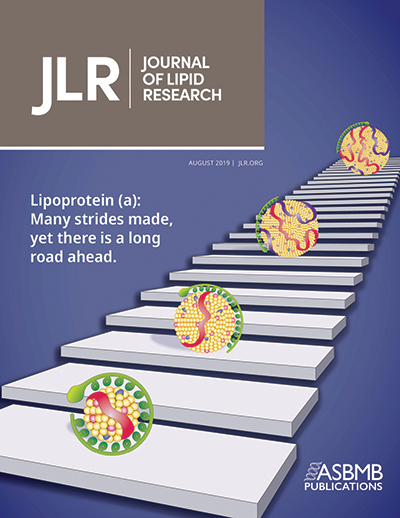JLR: Virtual issue sheds light on a key risk factor for heart disease
Because lipids such as cholesterol and triglycerides are hydrophobic and tend to clump up, rather than dissolve, in water, they need help getting around inside the body. Lipoproteins are complex assemblies with hydrophilic outer shells that package hydrophobic lipids in their core, allowing them to hitch a ride through the bloodstream. These delivery particles play an important role in the absorption of dietary lipids from the small intestine and also transport lipids to and from the liver.
 The cover of the JLR virtual issue depicts the Lp(a) particle following the steps of a walking path, getting bigger as the road stretches into infinity.
The cover of the JLR virtual issue depicts the Lp(a) particle following the steps of a walking path, getting bigger as the road stretches into infinity.
High levels of one particular class of lipoprotein, known as lipoprotein (a), are associated with atherosclerosis, inflammation and thrombosis, but no treatments are available in the clinic that specifically lower Lp(a), and much of what governs Lp(a) assembly is still unknown.
A new from the Journal of Lipid Research titled “Lipoprotein (a): Many strides made, yet there is a long road ahead” explores the past, present and future status of Lp(a) research and showcases researchers pushing this field forward. This issue was assembled by JLR Junior Associate Editor from Columbia University Irving Medical Center in New York City.
Several papers collected in this issue offer insights into how various Lp(a)-reducing drugs work. In one of these studies, and colleagues at the University of California, Davis, and the University of Hong Kong demonstrated that alirocumab — an inhibitor of the lipid-binding enzyme PCSK9 — could lower Lp(a) levels regardless of the isoform of proteins in Lp(a).
A study by and an international team of researchers suggests that another PCSK9 inhibitor, evolocumab, reduces Lp(a) levels partly by increasing the expression of LDL receptors.
Elisa Waldmann and at Ludwig Maximilian University of Munich wrote a review that discusses apheresis as an effective method of selectively clearing Lp(a) from the blood and reducing risk of cardiovascular disease.
Another review, penned by at McGill University, describes the association of Lp(a) with aortic valve disease and outlines steps toward developing much-needed preventive and therapeutic strategies.
Enjoy reading ASBMB Today?
Become a member to receive the print edition four times a year and the digital edition weekly.
Learn moreGet the latest from ASBMB Today
Enter your email address, and weвҖҷll send you a weekly email with recent articles, interviews and more.
Latest in Science
Science highlights or most popular articles

Guiding grocery carts to shape healthy habits
Robert вҖңNateвҖқ Helsley will receive the Walter A. Shaw Young Investigator in Lipid Research Award at the 2025 ASBMB Annual Meeting, April 12вҖ“15 in Chicago.

Quantifying how proteins in microbe and host interact
вҖңTo develop better vaccines, we need new methods and a better understanding of the antibody responses that develop in immune individuals,вҖқ author Johan Malmström said.

Leading the charge for gender equity
Nicole Woitowich will receive the ASBMB Emerging Leadership Award at the 2025 ASBMB Annual meeting, April 12вҖ“15 in Chicago.

CRISPR gene editing: Moving closer to home
With the first medical therapy approved, thereвҖҷs a lot going on in the genome editing field, including the discovery of CRISPR-like DNA-snippers called Fanzors in an odd menagerie of eukaryotic critters.

Finding a missing piece for neurodegenerative disease research
Ursula Jakob and a team at the University of Michigan have found that the molecule polyphosphate could be what scientists call the вҖңmystery densityвҖқ inside fibrils associated with AlzheimerвҖҷs, ParkinsonвҖҷs and related conditions.

From the journals: JLR
Enzymes as a therapeutic target for liver disease. Role of AMPK in chronic liver disease Zebrafish as a model for retinal dysfunction. Read about the recent JLR papers on these topics.

